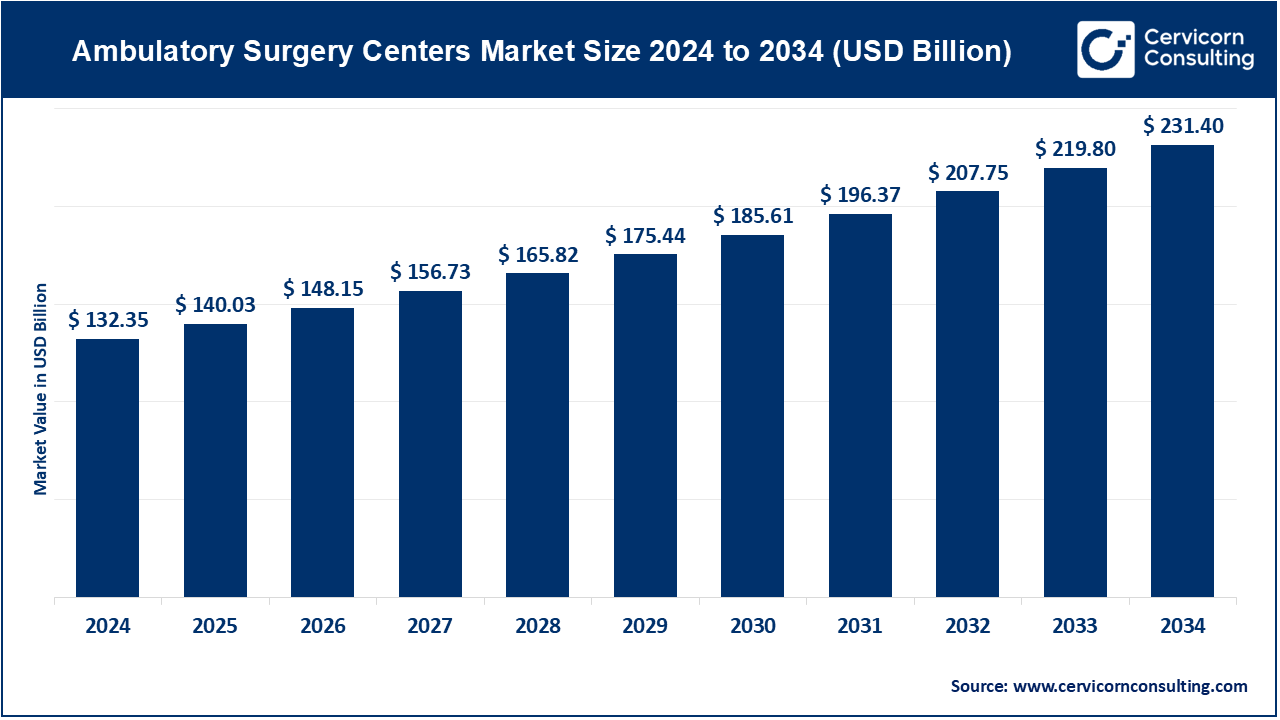Ambulatory Surgery Centers Market Overview
The global ambulatory surgery centers (ASC) market was valued at USD 132.35 billion in 2024 and is projected to climb to USD 231.40 billion by 2034, registering a CAGR of 5.79% from 2025 to 2034. This expansion underscores the growing emphasis on outpatient care, the increasing popularity of minimally invasive surgeries, and the ongoing push for cost-effective solutions by both providers and payers.
ASCs have become an integral part of today’s healthcare landscape, delivering patients affordable and high-quality surgical services outside of conventional hospital environments.
👉 Get a Free Sample: Click here
Key Market Trends
1. Transition to Minimally Invasive Procedures
Ongoing innovations in surgical tools—such as robotic-assisted technologies, laparoscopic equipment, and advanced imaging systems—are making minimally invasive surgeries more accessible. These procedures require shorter recovery times, positioning ASCs as the preferred care setting. Surgeries like cataract removal, arthroscopy, and endoscopy have notably shifted from hospitals to ASCs.
2. Adoption of Digital Health & Remote Monitoring
ASCs are integrating digital platforms including electronic health records (EHRs), AI-based scheduling systems, and remote monitoring tools. These not only streamline operations but also strengthen patient engagement during recovery. The incorporation of telehealth for pre-operative consultations and post-operative follow-ups is a rising trend.
3. Expanding Reimbursement Policies
Governments and insurers are broadening coverage for ASC-performed procedures. For instance, in the U.S., the Centers for Medicare & Medicaid Services (CMS) has consistently added new reimbursable ASC procedures, encouraging more surgical specialties to move away from hospital-based care.
4. Growing Patient Preference for Cost-Efficient Care
Patients are gravitating toward ASCs due to reduced costs, quicker turnaround times, and personalized services. Procedures conducted in ASCs are typically 35–50% cheaper than hospital-based outpatient surgeries, making them appealing for both insurers and patients paying out of pocket.
5. Rise of Specialty-Focused Centers
Dedicated ASCs specializing in fields like orthopedics, ophthalmology, gastroenterology, and pain management are on the rise. Specialization improves efficiency, enhances outcomes, and creates competitive advantages in the market.
Market Drivers
-
Growing Volume of Outpatient Surgeries
Currently, more than 60% of surgical procedures are performed in outpatient facilities. This trend, driven by patient convenience and hospital capacity pressures, is propelling ASC adoption. -
Cost Savings for Healthcare Systems
ASCs offer significant savings compared to hospitals. According to the Ambulatory Surgery Center Association (ASCA), Medicare alone saves over USD 4.2 billion annually by shifting procedures to ASCs. -
Government and Insurance Incentives
Reimbursement expansions, bundled payment systems, and favorable regulatory policies are strengthening ASC penetration in global healthcare systems. -
Advancements in Surgical Technologies
Enhanced anesthesia methods, robotics, and imaging solutions enable complex surgeries—including joint replacements and spinal interventions—to be safely carried out in ASCs. -
Demographic Pressures
The rising elderly population and the prevalence of chronic diseases like diabetes, arthritis, and cardiovascular conditions are increasing the need for surgical interventions, particularly orthopedic and ophthalmic procedures that dominate ASC volumes.
Impact of Trends and Drivers
-
By Segment: Orthopedic, ophthalmology, and gastroenterology ASCs are recording the fastest growth, fueled by demand for minimally invasive and specialty-focused care.
-
By Region: North America remains the market leader, thanks to favorable reimbursement frameworks and robust infrastructure. Meanwhile, Asia-Pacific is witnessing the highest growth rate, driven by healthcare investment and a growing demand for affordable outpatient solutions.
-
By Application: Elective and diagnostic surgeries are migrating rapidly to ASCs, alleviating hospital workloads and improving cost efficiencies across health systems.
Challenges & Opportunities
Challenges
-
Regulatory inconsistencies across global markets.
-
Shortages of skilled surgeons and nursing staff.
-
IT integration issues with hospital networks.
Opportunities
-
Growth potential in emerging economies with expanding middle-class populations.
-
Rising adoption of AI-powered workflow optimization tools.
-
Increasing demand for specialty-oriented ASCs in cardiology, pain management, and orthopedics.
Future Outlook
The ASC market is on a steady upward trajectory, forecast to reach USD 231.40 billion by 2034. With a CAGR of 5.79%, the future landscape will be shaped by cutting-edge surgical innovations, digital health integration, and patient-centric models of care. Broader adoption of robotics, AI-supported decision-making, and highly specialized centers will define the next era of ASC development, offering patients safer, faster, and more cost-effective treatment options.
📌 Contact for Detailed Market Insights: Click here

